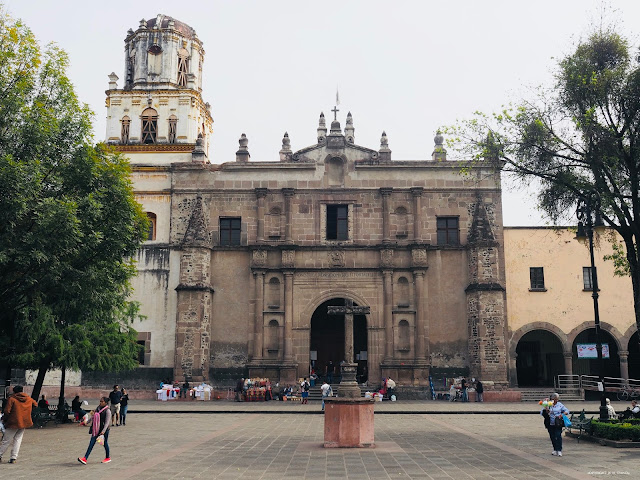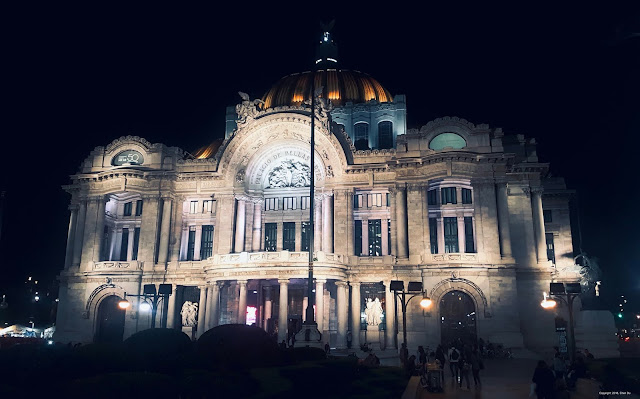Chapter Five Coyoacán
The Uber driver apparently wasn't familiar with my destination. I knew he went the wrong way, and you know what? I'm not even from Mexico City.
I asked the driver to stop. He asked me several times in English:" Are you sure this place?".
I nodded.
He cautiously said "Adios". I could tell that he was a bit worried that he might just took a stranger to the wrong spot in a city known for its sheer size, especially when the trip lasted 50 minutes.
On my end, it would be a lengthy and costly mistaken if I did end up arriving at the wrong spot.
However, I knew I didn't.
In fact, when I all of sudden saw the driver drifting away from Diego Rivera's final masterpiece in the rear window, I knew the driver was heading the wrong way. I had to make him stop......
 |
The final masterpiece of Diego Rivera : The mural at the Olympic Stadium |
Many artists and designers never ended up seeing the completion of works we today see as masterpieces during their own life time. Michelangelo never saw the completion of the dome of St Peter's Basilica. In fact, Antoni Gaudi, and the rest of us, still haven't seen the completion of Sargrada Familia. The same goes with Diego: He planned to decorate the exterior of a stadium in his neighbourhood university with what he was good at. However, he died before he was able to do so. This resulted in the stadium having a Rivera-esque stone mural at one of its entrances. In 1968, this mural became famous around the world - as the stadium was used for the opening ceremony of the 1968 Mexico City Olympic Games.

The stadium is part of the the campus of UNAM (National Autonomous University of Mexico ). It is one of the few universities in the world that was designated as an "UNESCO World Heritage Site" - for its "outstanding example of urban architecture design" . Other than Rivera's mural at the stadium, there were many other murals - the most famous being the one depicted on the University's central library. The entire wall of the library was done in small tiles - just like how pre-Hispanic murals were made. The mural depicted the history of how people of Mexico perceived the world. It started with the ancient Ameri-indian's view of the universe, which was full of supernatural beings and events. On the opposite wall, two types of world views were depicted - one that was driven by official Catholic doctrines, which was brought by Spanish colonists and symbolized by the Ptolemaic map of the universe showing that earth is the centre of the universe; while the other was driven by science, which was symbolized by the Copernican map of the universe showing that the sun is the centre of our solar system. However, the creator of the mural didn't think the scientific age was necessarily a good thing. Advanced weapons like canons were created, which brought war, conquest, and suffering to Mexico and its people.
 |
The Campus of UNAM |
 |
The Wall depicting the two world views: one of the medieval Catholic church, and one of modern science |
There are also many other murals across UNAM campus. Despite being created quite some time ago, they still gave me a futuristic feeling. Somehow I felt I was walking in a place that inspired Pink Floyd's music. Hello? Is anybody in there? Readers, I wish you were there, and I'll see you on the dark side of the moon. All in all, we are just another brick in the wall.
 |
A human hand shaking a robotic hand |
Nearby is the neighbourhood of Coyoacan where Diego Rivera and his equally famous wife Frida Kahlo lived. The Casa Azul was where Kahlo was born, lived and died. The long line and hefty admission (by Mexican standard), in my opinion, isn't worth the hassle as you can see some of her most famous works either for free (like Tate Modern in London) or in museums dedicated for the purpose of public education. Most visitors I saw at Casa Azul were instagramers - if you are one, you know you can't miss it. If you are not, you know what your experience will be like.
 |
Casa Azul - "The Blue House" |
 |
Self portrait of Frida Kahlo |
 |
The courtyard of Casa Azul |
There is one alternative though, if you really want to find out how exactly heritage homes in this neighbourhood are like. Consider visiting Leon Trotsky's home just a couple blocks away. This traditional Coyoacan home, too, has some historic significance attached to it. It was the place where Trotsky - the founder of the Soviet Red Army was assassinated by Stalin's spy. The study where Trotsky was murdered with a mountain climbing axle remained the same as the day of his demise.
 |
Leon Trotsky's home in Coyoacan. Now a museum |
 |
Trotsky's glasses |
 |
Trotsky's desk remains the same as the day he was assassinated right by it |
 |
Trotsky's study |
 |
Where Trotsky and his wife, Natalia Sedova were buried |
I like Coyoacan not simply because of whoever famous once lived there. It was a good place to see everyday life in Mexico - without the hype of carefully tailored mass tourism (yes, I'm talking about those 'day trips' offered at Mexican resorts) or the elitist culture found in posh neighbourhoods like Polanco and Condesa . Indeed, there has always been two sides of Mexico - one that appears on tourist brochures advertising the country as a playground for people of all classes in U.S and Canada; while the other is simply being, well, Mexico (which according to the same crowd that belong to the former, is a hell hole full of violence and poverty one should definitely stay away). The funny thing was that for all these days spanning three different cities, I had yet to have even one sip of alcohol. However, every single day I always ended up attending Catholic mass somewhere - whether it was at a certain city's landmark cathedrals, or in Coyoacan's case, inside a public market amid the strong smell of raw meat and stinky fruit. Sorry, tequila what? You are asking the wrong person who apparently went to the wrong Mexico. (Here is something super ironic: I love tequila, and I'm not Catholic at all)
 |
Man, Controller of the Universe by Diego Rivera (Photo Credit to: Wikipedia) |
The mural was supposed to be in the lobby of New York's Rockefeller Center (30 Rockefeller Plaza). Because the Rockefellers didn't like Lenin being depicted in the mural, they eventually let Rivera go and demolished the would-be masterpiece. To Diego Rivera, he couldn't even control this outcome. He had no choice but to create a smaller version of the same mural in Mexico City's Palacio de Bellas Artes.
 |
The main performance stage at Palacio de Bellas Artes |
One of the characters depicted on the mural, Leon Trotsky, never managed to return to the Soviet Union. In fact, he was murdered by Stalin's agent inside his own house. Even Trotsky couldn't control his own fate.
 |
The decoration on the celling of the main performance hall |
Guess what? I've always wanted to see this mural in person. During my brief tour of Palacio de Bellas Artes during the intermission of a folk ballet show, I never found it. Either the man sitting at the control desk didn't want me to see the mural, or nobody can control the outcomes of events in their lives.
(To Be Continued)
































Comments
Post a Comment